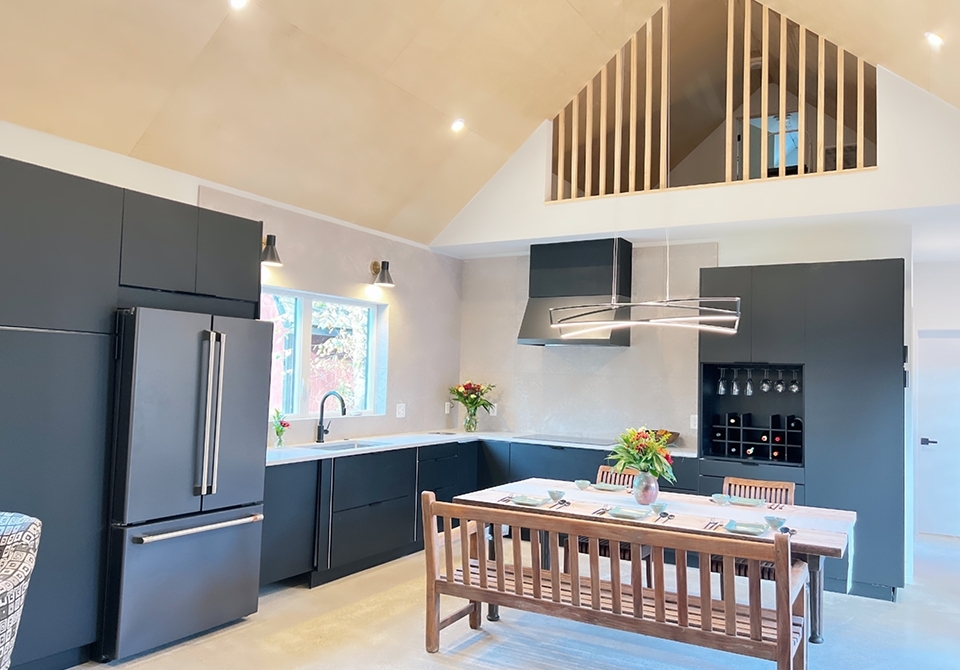
Using Cellulose for a Net-Zero Accessory Dwelling Unit
When it comes to choosing the right materials for a home, insulation is a critical part of the equation. With energy codes evolving throughout the United States, architects and developers across the country are driven to rethink their approach to design and construction and make innovative design choices that transform sustainable building into a reality.
Symbi Homes, a residential development company in Hyattsville, Maryland, did just that with the recent use of SANCTUARY® by Greenfiber. The Symbi Homes team agrees SANCTUARY contributed to a more sustainable build with impressive insulating and soundproofing properties.
“As a green builder, we’re always looking for products that are more sustainable and are better for the environment, and you don’t get much better than cellulose,” said Nicole Tysvaer, owner of Symbi Homes. “Not only are we carbon neutral in the manufacturing of this product, but we're also capturing carbon within the walls of the home.”
Designing a home for comfort and sustainability? Read on to discover how you can build a home like the Regeneration House and achieve the same benefits.
Reducing a Home’s Carbon Footprint with Cellulose Insulation
One of the main goals for the Regeneration House project, a two-story, 19th-century Victorian home restoration, was to increase the square footage with the addition of a new net-zero in-law suite. Net-zero dwellings are built to produce as much energy as they consume in a year. To provide added protection beyond that of fiberglass or spray foam insulation — where sound can escape between gaps — Symbi Homes opted for cellulose insulation in the in-law suite.
Made from up to 85% recycled material, cellulose uses less energy to manufacture than other types of insulation and is designed to keep carbon locked in for the life of a home’s structure. With the installation of SANCTUARY, the Regeneration House in law-suite will:
- Have a tighter thermal envelope
- Be protected from moisture accumulation
- Need less electricity for heating in the winter and for air conditioning in the summer
These benefits not only reduce a home’s carbon footprint but also make for a more comfortable living experience.
Homes with existing insulation are not out of luck. Cellulose insulation is popular in retrofit applications because it can be installed over existing insulation. Whether it’s loose-filled, dense-packed or spray-applied, Greenfiber cellulose insulation makes the process quick and easy and ensures your project will reach the necessary R-value with minimal labor. In fact, Symbi Homes was so impressed with the product, they also retrofitted the main house with SANCTUARY.
Applying SANCTUARY Cellulose Insulation to Cathedral Ceilings
Cathedral ceilings, elevated enclosures designed to draw the eye up, can add an element of splendor to any home — but it’s important that they’re built properly. For Symbi Homes’ Regeneration House, cellulose insulation was the key ingredient in ensuring the sustainability of the home’s roof. Dry dense-packing the ceiling was as simple as the decision to choose cellulose to get the job done.
• Dense-packing the ceiling: The typical installation method for dry dense-packing cathedral ceilings is to staple a nonwoven netting to the cathedral rafters. A hole is then cut in the netting near the ridge, and a 2 1/2" or 3" hose is inserted the length of the cavity. Insulation is blown into the netted cavity to a minimum density of 3.5 pcf. At this density, there will not be any settling of the material.
Impressed by cellulose’s soundproofing properties, the Symbi Homes team installed SANCTUARY in the wall cavities, too:
• Spray-applying SANCTUARY to wall cavities: SANCTUARY cellulose insulation can be sprayed into open wall cavities to provide exceptional thermal insulation, fire protection and sound control. This method completely permeates the wall cavity with SANCTUARY, filling all the gaps, crevices, nooks and crannies.
Want to see the installation unfold? Watch the installation of a cathedral ceiling in the Regeneration House in-law suite, and then take a deep dive into Greenfiber’s application guide.
Building Your Net-Zero Home with Cellulose Insulation
The Regeneration House is a model for how to reduce your carbon footprint and greatly increase a home’s well-being. Greenfiber insulation is the first all-in-one cellulose insulation that can be spray-applied or dense-packed into walls, ceilings and floors. Installing cellulose in these areas can reduce unwanted noise by 60% and make it easier to regulate temperature from floor to floor and room to room. [1]
Feeling inspired? Learn more about the benefits of SANCTUARY and how to incorporate cellulose insulation in your next retrofit with the help of a Trusted Installer.
[1] In field testing on identical 2x4 exterior wall types, Greenfiber® R-13 stabilized spray-applied insulation outperforms R-15 unfaced fiberglass batts by 4 NIC rating points, which equates to a 60% reduction in sound power. The weak point in the assembly such as flanking through windows and doors will diminish the value of the reduction in sound power. Reduction in sound power is achieved through retrofitting, dense-packing or spray-applying Greenfiber into exterior walls (contractor installation is recommended for these applications). See manufacturer’s installation guide for full details on how to install to meet specifications.
Photo courtesy of Symbi Homes.
- Category: Projects, Sustainability
